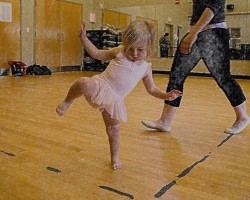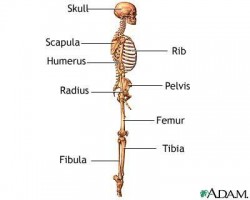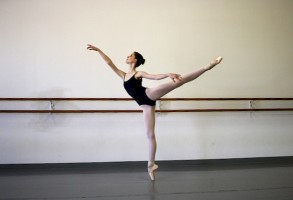
“Balance is, simply put, the ability to stay stable and not fall as we move within and beyond our base of support (normally our feet in everyday navigation).” [link]
When we think of balance, especially in dance, our mind goes to moments when balancing is a challenge – perhaps standing en relevé or maintaining a pose on one leg.
But our everyday movements, like walking, require this ability to balance as well. We are making constant adjustments, using our senses and our muscles, as we stand, shift, change, and move our bodies through space. This is balancing, something we’ve been gradually learning to master since we were babies.
Because it’s relevé, arabesque, or the tilt you teacher put in your contemporary dance that may be giving you trouble, I’m going to give some tips and thoughts to improve your overall balancing of poses. But just like when you were little, learning to balance is very much about trial and error. Each time you explore, challenge yourself, try and fail, and try again, your body is learning how to better balance itself.
Constructing a Balance
Alignment
When building a vertical tower of blocks, the tower is most stable when each block is stacked directly on top of the one below it. This is true when balancing your body in a vertical position as well. In dance, this stacking of the body may be referred to as, or considered part of the concept of alignment.
 The ankles are stacked directly over your base of support, the knees over the ankles, the hips and pelvis over the knees, rib cage over the hips, the shoulders over the rib cage, the head and neck topping off the tower.
The ankles are stacked directly over your base of support, the knees over the ankles, the hips and pelvis over the knees, rib cage over the hips, the shoulders over the rib cage, the head and neck topping off the tower.
When something is out of place, it is still possible to maintain a pose but it may not be as stable or healthy for the bones and muscles that must work to support the position. When one thing is out of place, something else must counterbalance the misaligned body part.
A common example is allowing the rib cage to “open” or jut forward when standing en relevé. With your rib cage displaced in this way, you will likely need to shift the shoulders back, or tilt the pelvis (creating a swayed back), or both in order to balance.
I won’t go into all the possible or common alignment corrections right now – each body part could have its own post. Your teacher is in the best position to help you individually.
Having a good working knowledge of how the body should be aligned is a gigantic part of maintaining a solid vertical balance.
Support
Strength and stability (or lack of these) in supporting muscles and joints can also affect your ability to balance. In relevé you may notice that your ‘ankles’ (actually it is the tarsus joint) are wobbly. The tendency is for dancers to supinate or roll toward their smallest toe (also called sickling) when in relevé. The body will try to correct and overcorrect looking for a stable alignment over the second or third toe. Someone with superior balancing ability makes these adjustments but they are much smaller, maybe even imperceptible. With weak or tired supporting muscles you will have larger adjustments to make and will wobble over your base of support.
Strengthening the muscles that allow for this side-to-side movement of the foot (supination and pronation) will give you more stability. There are many exercises that help with strength and control in this area but the most straightforward is practicing sets of relevé, first in a slow, smooth manner so that you can detect any of this sideways motion as you rise. The goal would be to rise each time with your weight directly over the second and third toe without supinating or pronating on the way up or down. Doing this under the watch of a trained eye (your teacher) will serve you best.
The muscles of the foot, ankle and lower leg are not the only muscles which support proper alignment of the body. In maintaining balance, an engaged and strong core (or center) – muscles of the torso (abdominals and back)- also play a key role in good balance. As in our earlier example, these muscles help to keep the shoulders over the ribs and hips, the rib cage in alignment over the hips, and the pelvis aligned. They also keep the torso from ‘sinking’ into the hips and legs.
Strengthening and learning to stabilize the core can be approached different ways. Your teacher is a great resource. You may Pilates or other exercises focused on the core but my best tip is to become a mindful dancer while you are in class – work to maintain proper alignment at all times, listen and apply corrections and you will gradually build awareness and strength that will help you with balancing (and lots of other things too).
Growing a Balance
We’ve talked about the structure of a balance and constructing a balance from ground up but. though you are maintaining a pose, there is constant motion involved (even when you reach the point of “stillness”). Also it may be easy to think of classical poses as a tall tower, but what about more contemporary, off-center, balances?
This is where I find the concept of growing a balance helpful.
Preparing for and getting into the balance is as important what happens once you are there. Whatever your preparation is – a plie, a shift of weight, a first position – maintain correct alignment with a strong connection or relationship to the floor. In these moments you are creating quality soil for planting your pose.
From this preparation, you’ll find it more natural to then grow from the ground up. In a simple relevé, for example, you’ll begin in a good first position with weight evenly distributed in the feet. The rise begins with your push from the floor and grows through your ankles, legs, pelvis, torso, neck and head but, it doesn’t stop there. You continue lengthening and growing as your roots go deeper.
The idea is the same whether your pose is a classical arabesque, a contemporary tilt, or a handstand. They all grow from the soil and branch upward and outward.
Opposing Energy
Your ability to balance can be greatly affected by how and what you think or imagine.
When balancing, you might be thinking really hard about holding yourself UP but actually DOWN is a pretty useful direction. As you rise to relevé or move into the position of your intended balance, think of pushing the floor away from you. Imagine roots embedding themselves deep into the ground while your branches (head, neck, and limbs) grow up or outward.
Eye Think Not
Sometimes dancers have the tendency to look down, even when they balance. I tell my students, “Keep your eyes on the floor and that’s where you’re likely to end up.” If you are a beginner, it may help to remember to keep your eyes lifted and focus outward. Imagine that you have x-ray vision and can look beyond the walls of your studio.
This outward focus can be a big help but remember that you can’t rely totally on vision for your balance. Dancers sometimes depend on it way too much. If you practice balancing only with a mirror in a well-lit room, you’ll find that balancing is much different and probably more difficult on stage.
Dealing with a changing center of balance
If you are a growing teen, you may suddenly find you are struggling with balances that were once easy. Sudden growth spurts can create a drastic change in your center of balance and also affect your ability to lift or extend longer limbs. I once had a 12-year-old dancer who had gotten really strong over the course of a year – her balances were stable, she was able to extend and hold her leg above 90 degrees, her movements were coordinated. Over summer break, she grew three or four inches and came back to class with longer everything – legs, torso, arms – and in many ways, it felt and looked like she was starting from scratch. If this is you, don’t get discouraged, keep working, practicing, and experimenting and you’ll soon learn to control your new body.

Balance Challenge
Once you can maintain a pose for a length of time try adding a new layer of difficulty:
- Move your head while balancing (left, right, tilt, up or down)
- Dim or have someone flicker the lights
- Close your eyes
- Balance on a soft or uneven surface like a pillow or tumbling mat
You can also improve your balance by exploring, moving into and through different kinds of balances:
- Stand on one leg and slowly move your torso, head, and arms in any or all directions – try symmetrical movements first, and then asymmetrical. Test and challenge your balance. Can you pick up the pace?
- Move and improvise to a piece of music. Don’t think of choreography but imagine that you are trying to touch every molecule around you with every part of your body and explore every inch of the room. Have a friend randomly pause the music (or you might use this Freeze Dance iPhone App if you’re alone). When the music stops, challenge yourself to freeze and balance in whatever position you’re in.
- Try the first exercise again but don’t just balance on your feet. Try “gluing” one or two body parts to the floor instead: a hand and a foot, your bottom, your knee, your shoulder and head. Experiment with moving and finding moments of balance this way.
For more:
Anaheim Ballet has produced a video on Balancing like a Ballerina which has some fun visuals. I especially like their one finger balancing tip (talk about mind over matter!). I learned of the video through The Dance Buzz, who I discovered also did a post on balancing recently. You can check out the video and Cait’s tips at The Dance Buzz. (BalletScoop has also featured the video along with some pirouette tips)
Got a great balancing tip or pointer? Add it in the comments!
A note to dance instructors: I recommend the article Understanding Balance found in the IADMS Bulletin for Teachers (Volume 2, Number 1) which suggests that exploration is the best tool for “teaching balance” to students. The article implies that our vocal cues like “Lift your kneecaps” or “Rotate the hip” during balance practice actually work against our dancers, interfering with their “automatic balance mechanisms.” Instead, researchers recommend that teachers provide plenty of trial and error opportunities for dancers to creatively problem solve within their own bodies. What they learn through these experiences and explorations will serve them as they practice in class. Incorporating creative improvisation exercises like the few listed above, as well as the balance challenges into your classes are excellent learning experiences for your dancers.
Also listen to the Annaleise Burns (of ABC for Dance) podcast with Deborah Vogel in which they discuss the differences for balancing on stage vs. in the studio and ways teachers can train students for balancing in all situations. Here is the link.
Nichelle Suzanne is a writer specializing in dance and online content. She is also a dance instructor with over 20 years experience teaching in dance studios, community programs, and colleges. She began Dance Advantage in 2008, equipped with a passion for movement education and an intuitive sense that a blog could bring dancers together. As a Houston-based dance writer, Nichelle covers dance performance for Dance Source Houston, Arts+Culture Texas, and other publications. She is a leader in social media within the dance community and has presented on blogging for dance organizations, including Dance/USA. Nichelle provides web consulting and writing services for dancers, dance schools and studios, and those beyond the dance world. Read Nichelle’s posts.


